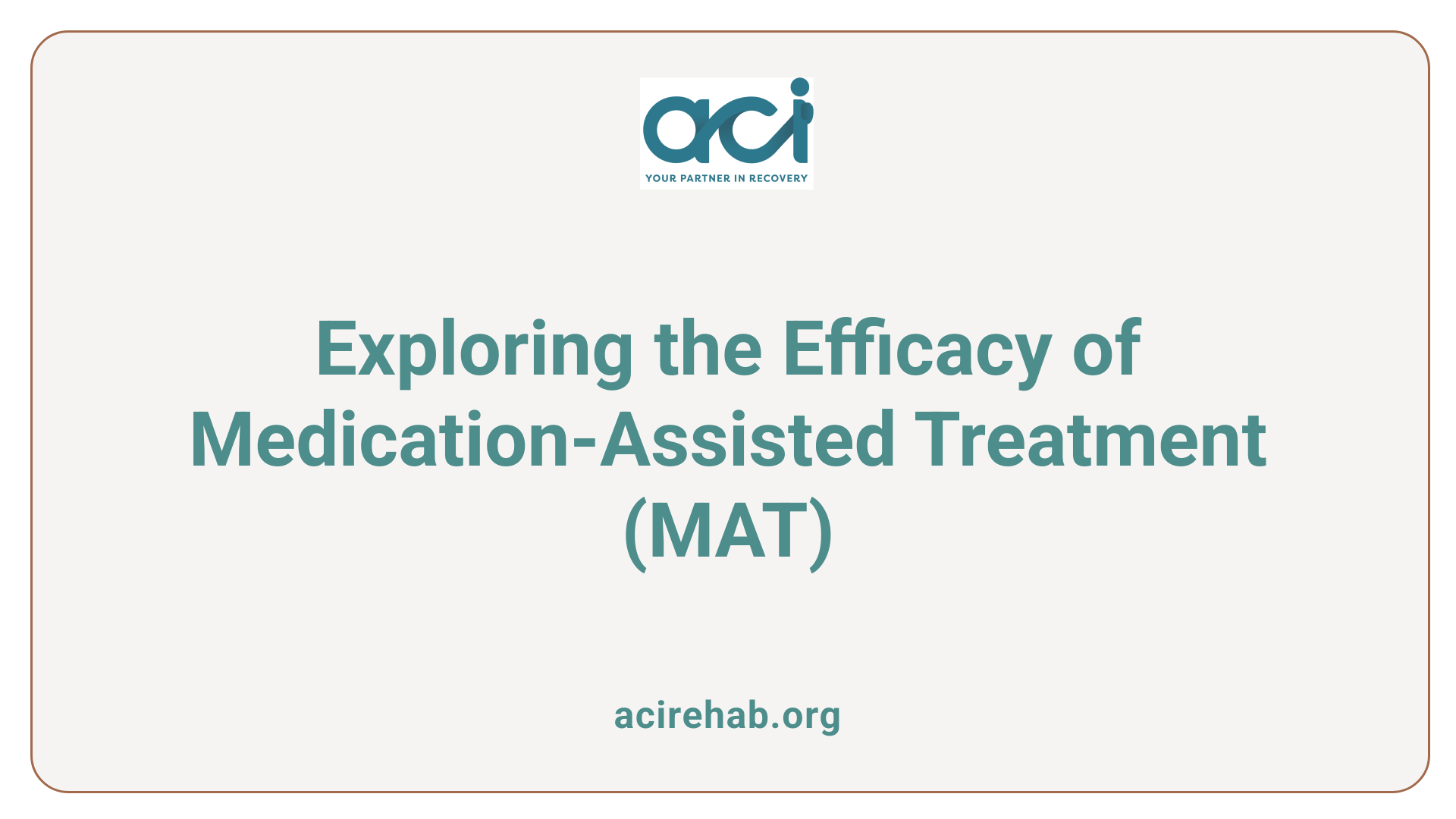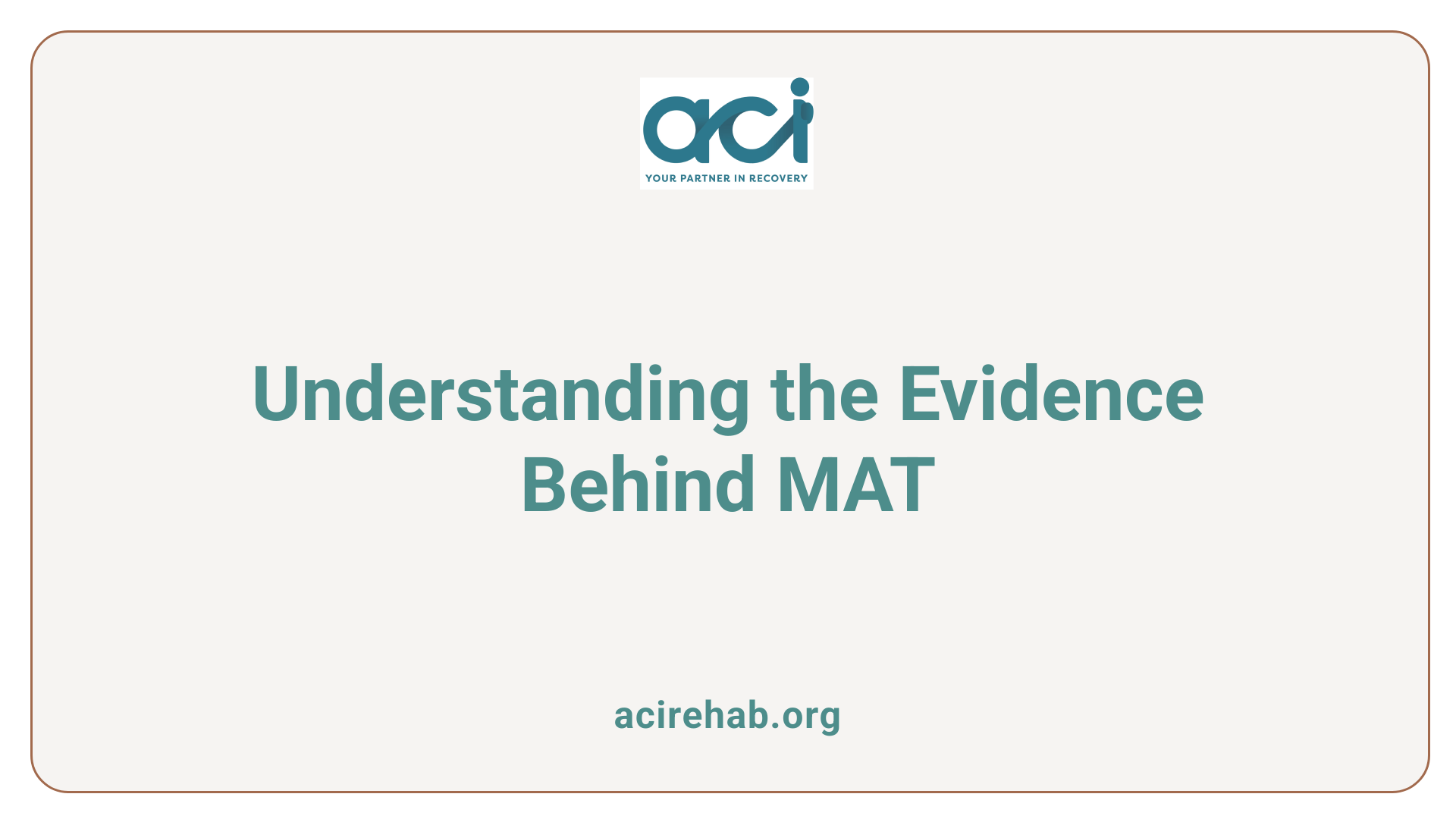Understanding Medication-Assisted Treatments
Medication-assisted treatment (MAT) has emerged as a leading strategy in the battle against opioid use disorder (OUD). Combining FDA-approved medications with behavioral therapies, MAT offers a comprehensive approach to tackling addiction. With its potential to save lives and enhance recovery outcomes, MAT represents a pivotal development in addiction treatment.
The Proven Efficacy of MAT

Effectiveness of MAT in Reducing Opioid Use
Medication-assisted treatment (MAT) has been demonstrated to be an effective approach in the treatment of opioid use disorder (OUD). This approach combines FDA-approved medications like methadone, buprenorphine, and naltrexone with psychosocial therapy, addressing both the physiological and behavioral aspects of addiction. Research indicates that patients on methadone or buprenorphine show significantly less illicit opioid use compared to those receiving only behavioral interventions. For instance, a comprehensive review highlighted that methadone maintenance led to 33% fewer opioid-positive drug tests among patients.
Furthermore, both methadone and buprenorphine have strong evidence bases supporting their clinical effectiveness. Patients receiving these agonist medications are more likely to stay in treatment, contributing to improved social functioning and lower rates of drug-related criminal behavior. It is notable that extended-release injectable naltrexone has also shown promise, especially in terms of treatment retention and increased opioid abstinence rates, with studies reporting 90% confirmed abstinence in comparison to 35% in placebo groups.
Impact on Overdose Reduction and Patient Outcomes
The implications of MAT extend beyond merely reducing opioid use; it effectively lowers the risk of overdose fatalities and improves overall patient outcomes. Individuals on methadone and buprenorphine have demonstrated a 50% reduction in mortality risk compared to untreated individuals. Moreover, MAT has been linked to increased treatment retention, which correlates with better long-term recovery outcomes.
Despite these benefits, stigma surrounding MAT remains a barrier, influencing policymakers and providers’ attitudes toward its adoption. Nevertheless, the growing scientific evidence positions MAT as an essential component of comprehensive addiction treatment strategies, demonstrating its effectiveness in saving lives and helping individuals reclaim their potential.
Evidence-Based Approach

Is medication-assisted treatment evidence-based?
Yes, medication-assisted treatment (MAT) for opioid use disorder (OUD) is thoroughly supported by evidence. The FDA has approved three primary medications—buprenorphine, methadone, and naltrexone—that have proven effective and safe in treating OUD. These medications not only assist patients in managing their addiction but also significantly reduce their risk of death from all causes, particularly overdose, when taken under medical supervision.
Research highlights that MAT is particularly effective when combined with counseling and behavioral therapies. This integrated approach yields better health outcomes, enabling individuals to effectively navigate the challenges of recovery. For instance:
- Methadone is known for reducing illicit opioid use and helping patients maintain stability. It leads to a 50% reduction in overdose mortality.
- Buprenorphine aids in cravings and withdrawal symptom management, showing effectiveness comparable to methadone in appropriate dosing.
- Naltrexone, particularly in its extended-release injectable form, has shown significant rates of opioid abstinence.
What are the FDA-approved medications for treatment?
Here’s a concise overview of the FDA-approved medications:
| Medication | Mechanism of Action | Key Effectiveness |
|---|---|---|
| Methadone | Full agonist | Reduces cravings and withdrawal; lowers overdose risk by 50%. |
| Buprenorphine | Partial agonist | Decreases opioid use; improves retention in treatment; effective in medium-to-high doses. |
| Naltrexone | Antagonist | Prevents relapse; benefits specific populations but has lower retention rates. |
As the FDA works to expand access to these essential medications, the combination of MAT with behavioral interventions continues to showcase superior treatment outcomes for those battling opioid addiction.
Impactful Success Rates
What is the success rate of medication-assisted treatment?
Medication-assisted treatment (MAT) boasts success rates typically ranging from 40% to 60%. It significantly enhances treatment outcomes for individuals battling substance use disorders. Research demonstrates that those undergoing MAT greatly experience reductions in opioid usage, lower rates of overdose deaths, and improved retention in treatment programs—framing MAT as a promising intervention.
The effectiveness of MAT extends beyond numerical success rates. It varies depending on a range of factors, including the specific substance being treated, the individual circumstances of the patient, and the support systems integrated into the care plan. Studies suggest that the combination of medications with counseling and therapy creates a holistic approach that addresses both the physiological needs and behavioral aspects of addiction.
Comparisons with non-MAT approaches
In comparison to non-MAT treatments, such as solely behavioral therapies or detoxification programs, MAT demonstrates superior effectiveness. Many individuals benefit from ongoing pharmacotherapy, which fosters longer-term recovery by stabilizing brain chemistry without inducing a high. This stabilization is essential in helping patients avoid reverting to illicit drug use.
Overall, while MAT is not universally applicable to every individual struggling with addiction, the evidence underscores its vital role in providing a safety net for many, ultimately leading to better outcomes and healthier lives.
Comparative Analysis of Methadone and Buprenorphine
How does the efficacy of methadone compare to buprenorphine?
The efficacy of methadone is generally recognized as higher than that of buprenorphine, particularly regarding patient retention in treatment. Studies have shown that individuals receiving methadone are less likely to drop out, yielding a relative risk of 0.8 for lower retention rates with buprenorphine.
Both methadone and buprenorphine effectively suppress illicit opioid use for patients who remain engaged in treatment. Evidence indicates that methadone treatment leads to fewer opioid-positive drug tests compared to buprenorphine, making it a preferred option for continuous opioid use disorder management.
In settings focused on detoxification, both medications demonstrate similar effectiveness in managing withdrawal severity. However, buprenorphine may have an advantage in terms of treatment completion rates. It’s also important to note that buprenorphine’s safety profile includes a lower overdose risk due to its ceiling effect, which can make it a safer choice in some scenarios. Nevertheless, for buprenorphine to be effective, it must often be prescribed at higher doses; lower doses are linked to increased relapse rates.
| Medication | Efficacy | Retention Rates | Safety Profile |
|---|---|---|---|
| Methadone | Higher overall efficacy | Better retention | Moderate risk |
| Buprenorphine | Effective but variable | Lower retention | Lower overdose risk |
Retention rates and safety
Retention in treatment plays a significant role in the effectiveness of opioid use disorder therapies, and methadone consistently outperforms buprenorphine in this regard. Long-term studies highlight that patients on methadone maintenance are more likely to adhere to treatment protocols and experience sustained recovery outcomes. The improved safety profile of buprenorphine makes it an attractive option, particularly for those concerned about overdose; however, this does not negate the overall effectiveness that methadone has shown in long-term substance use management.
MAT Program Retention Rates
How successful is the medication-assisted treatment program overall?
The medication-assisted treatment (MAT) program demonstrates significant promise, particularly in terms of its retention rates. A systematic review encompassing 58 studies from low- and middle-income countries found an average retention rate of 54.3% after 12 months of participation. Notably, programs utilizing methadone showed a retention rate of 56.6%, while those with buprenorphine recorded a lower rate of 48.3%.
Although these figures suggest effective outcomes, it’s essential to consider that various factors, including dosage levels, were analyzed—but none exhibited statistically significant influences on retention. As detailed in the review by Feelemyer et al., the confidence level in the findings is relatively low, indicating variability across the studies.
Factors influencing retention in treatment
Retention in MAT programs is influenced by multiple factors, such as the type of medication used, patient engagement, and the presence of psychosocial support. For instance, both methadone and buprenorphine require careful monitoring to ensure optimal dosing, which is critical for reducing cravings and maintaining stability in patients.
Moreover, patient adherence improves with the integration of behavioral therapies alongside medication. The overall success of MAT programs is also contingent upon addressing barriers to access, such as stigma and availability, to ensure that more individuals can benefit from these lifesaving treatments.
Exploring the Mechanism of Action
Mechanisms behind MAT medications
Medication-assisted treatment (MAT) utilizes three primary FDA-approved medications: methadone, buprenorphine, and naltrexone, each functioning through distinct mechanisms to combat opioid use disorder (OUD).
- Methadone is a full agonist, binding to opioid receptors in the brain to alleviate cravings and withdrawal symptoms while blocking the euphoric effects of opioids.
- Buprenorphine, a partial agonist, also binds to opioid receptors but produces a milder effect, decreasing withdrawal without the high, which helps lower the risk of misuse.
- Naltrexone functions as an opioid antagonist. It blocks the effects of opioids completely, making it effective in relapse prevention after detoxification.
How they support recovery
The combination of these medications with behavioral therapies improves treatment adherence and enhances recovery.
- Improved retention rates: Patients on methadone or buprenorphine are more likely to stay in treatment, contributing to consistent recovery.
- Social functioning: Engaging patients helps improve their quality of life and encourages community participation.
- Reduced risk behaviors: MAT reduces the chances of engaging in risky behaviors, such as needle sharing, thus lowering the transmission of infectious diseases like HIV and hepatitis C.
Access and Utilization Challenges
Barriers to MAT Access
Access to Medication-Assisted Treatment (MAT) for opioid use disorder faces several obstacles that prevent many individuals from receiving the necessary support. Among the significant challenges are:
- Insufficient Trained Providers: A lack of qualified healthcare professionals trained to prescribe and manage MAT is a pressing issue.
- Regulatory Barriers: Policies often restrict the availability of treatments, adding layers of complexity for both providers and patients.
- Stigma and Misconceptions: Persistent societal stigma surrounding opioid addiction and the use of MAT can discourage individuals from seeking help.
- Insurance Limitations: Many insurance plans impose restrictions on coverage for MAT, reducing the accessibility of effective medications.
Impact on Treatment Availability
These barriers substantially affect the availability and utilization of MAT. Notably, in 2021, around 2.5 million adults in the U.S. had opioid use disorder, but only 22% received MAT. Alarmingly, only 36% accessed any form of substance use treatment. Disparities are stark, with men being six times more likely and non-Hispanic White individuals functioning 14 times more likely to receive medications compared to women and non-Hispanic Black adults.
A snapshot from March 2020 shows over 311,000 individuals received methadone and nearly 32,000 received buprenorphine on a single day, underscoring the demand for expanded access to treatment options that can save lives and improve recovery outcomes.
MAT: A Vital Component of Addiction Recovery
As opioid addiction continues to pose a significant public health challenge, medication-assisted treatment (MAT) stands out as a highly effective solution. By reducing opioid-related deaths and improving retention in treatment, MAT reshapes the landscape of addiction recovery. Expanding access and overcoming existing barriers are imperative to ensuring that every individual struggling with opioid use disorder receives the support they need. The ongoing development and integration of MAT into various healthcare settings will be crucial in addressing this crisis and supporting individuals on their journey to recovery.
References
- How effective are medications to treat opioid use disorder?
- Medication-Assisted Treatment Improves Outcomes for Patients With …
- The Effectiveness of Medication-Based Treatment for Opioid Use …
- Effectiveness of medication assisted treatment for opioid use in …
- An Overview of Medication-Assisted Treatment for Opioid Use
- Information about Medications for Opioid Use Disorder (MOUD) – FDA
- [PDF] Medication Assisted Treatment for Opioid Use Disorders: – UW ADAI
- Medication-Assisted Treatment FAQ
- Medications for Opioid Use Disorder Improve Patient Outcomes

